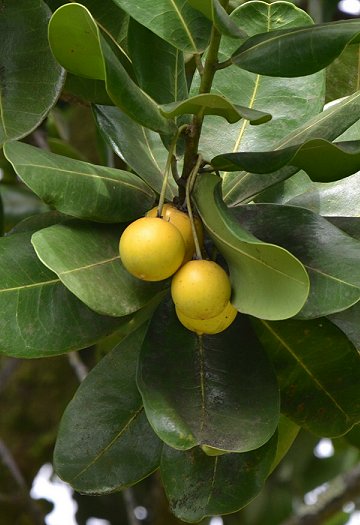
|
|
Balata (Manilkara bidentata).
Leaves and fruits.
|
Balata - Manilkara bidentata
Manilkara bidentata (Balata) is a species of Manilkara native to a large area of northern South America, Central America and the Caribbean. Common names include bulletwood, balatá, ausubo, massaranduba, and (ambiguously) "cow-tree".
The tree is harvested from the wild as a source of food, medicines, latex and wood. The latex makes an excellent quality rubber and the tree is sometimes grown for this purpose. Although growth is slow, balata is also cultivated for shade and timber.
Balata is a large, evergreen forest tree. Mature trees can reach a height of 30 - 45 metres, with a bole 1.3 - 2 metres in diameter.
Large boles can be up to 2 m in diameter and branchless for up to 18 m., and have broad rounded buttresses, spreading at the base.
Balata has a dense crown of horizontal branches. Its leaves are shiny green above and light brown underneath, alternate, elliptical, and 10-20 cm long.
The flowers are white, and are produced at the beginning of the rainy season. The fruit is a yellow berry, 3–5 cm (1.2–2.0 in) in diameter, which is
edible, and usually contain a single, shiny, black seed, surrounded by a sweet, gummy
pulp.
The fruit, like that of the related sapodilla (M. zapota), is edible.
Although no specific information has been seen for this species, the sap from some of the other species within the genus can be used as a substitute for cow's milk. The latex has the consistency and taste of cream, but overindulgence in it can result in severe constipation.
A latex obtained from the stems is used as an effective cure for dysentery.
The bark is emetic. A decoction of the bark, combined with the barks of Hymenaea sp. and Humiria sp., is used as an effective cure for dysentery.
The leaves are used for treating paralysis of the limbs.
The latex is extracted in the same manner in which sap is extracted from the rubber tree. It is then dried to form an inelastic rubber-like material. It is almost identical to gutta-percha (produced from a closely related southeast Asian tree), and is sometimes called gutta-balatá.
Gutta-percha is a natural latex obtained from the sap of the tree. Allowing this fluid to evaporate and coagulate in the sun produces a hard and durable latex which can be made flexible again with hot water, but which does not become brittle.
Prior to the advent of synthetic materials, gutta-percha had a wide range of uses - most particularly as an insulating material for electricity wiring and for underwater telegraph wires, a purpose for which it is very well suited since it is bio-inert and so is not attacked by marine plants or animals.
Gutta-percha can be moulded into any shape and has been used to make items such as ornate furniture, pistol grips, acid-resistant receptacles and ‘mourning’ jewellery, where its dark colour was an advantage. It has been widely used as the core of golf balls and is still used in modern dentistry where its bio-inertness makes it ideal as a temporary filling for teeth and as a filling material inside tooth fillings.
The tree is a hardwood with a red heart. The wood is used as construction material and for making furniture. It is extremely hard, heavy, tough, and strong. It is highly resistant to fungi, dry borers, and termites, but is susceptible to marine borers. Balata tree is slow growing and highly tolerant to strong winds.
A strong and attractive wood that resembles mahogany, it is highly valued commercially and is widely used in the tropics for railway sleepers, bridging, heavy construction, furniture, turnery, flooring, violin bows, and billiard cues. Its strength, high wear resistance, and durability qualify the timber for use in textile and pulp mill equipment. Its excellent steam-bending properties make it suitable for boat frames and other bent work.
Source:
https://en.wikipedia.org/wiki/Manilkara_bidentata
http://tropical.theferns.info/viewtropical.php?id=Manilkara+bidentata
https://pfaf.org/user/Plant.aspx?LatinName=Manilkara+bidentata
